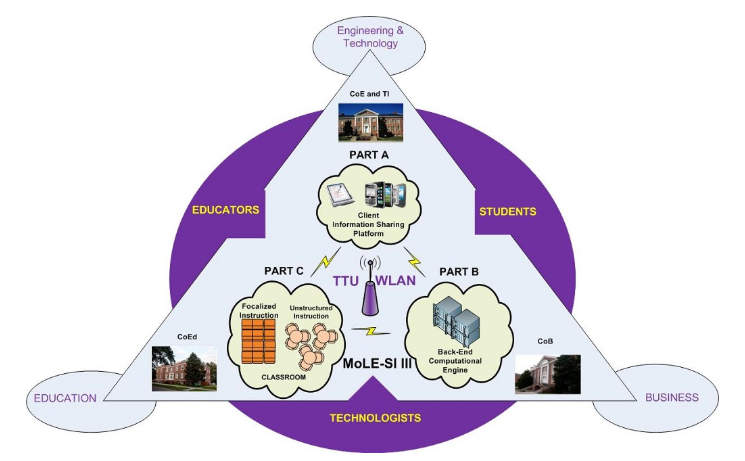The Mobile Learning Environment System Infrastructure (MoLE-SI) project was vital for the technological components that are integrated into the pedagogical and resources aspects of the Renaissance Foundry Model. Again, inspired by the connections made between an interdisciplinary group of scholars, the MoLE-SI project allowed students to leverage the internet and wireless capabilities to access resources – the central element of the Foundry Model – as part of their holistic learning experiences. The focal image below provides a holistic illustration of the main components of the MoLE-SI project.

The Background
MoLE-SI is composed of three key parts, a client sharing information component (involving the student and their netbook/notebooks); a back-end (remotely accessed) computational infrastructure, and high tech classroom with the ability to implement both “focalized” and “unstructured” learning environments.
The successful implementation of MoLE-SI complements current ITS efforts, takes full advantage of the new wireless infrastructure, and changes the culture on how to use computer technology within the STEM disciplines, everywhere. Driven by the need to transform the current status of fixed PCLABs into a flexible and mobile learning environment, Chemical Engineering conducted a pilot in collaboration with the Office of the Dean of the College of Engineering and assistance from Apple and Lenovo during the 2009 Fall Semester. With student input, MoLE-SI (Mobile Learning Environment System Infrastructure) was conceptualized and data was gathered, analyzed and presented to the College of Engineering, College of Business, Department of Computer Sciences, and Department of Chemistry. Furthermore, such data was complemented with experience from Computer Science and the Technology Institute, and feedback from ChE students from two different levels, sophomores and seniors as well as the entire faculty in Chemical Engineering. It was decided that the unit/s level pilot was a promising step before making a decision for implementation at a college level.
While MoLE-SI offers a entire new set of advantages in terms of pedagogical use of technology, student flexibility in time and mobility in space, since it has never been tested in large scale, it requires decision making in term of scalability and performance in order to optimize cost. The core goal of this proposal is to assess MoLE-SI at the educational unit level with the purpose of validating findings of the small scale pilot and establishing safe guidelines for an eventual scaling towards a college or university level implementation.
Additional Resources
MoLE-SI at Tennessee Technological University